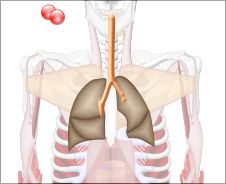
We all have experienced the following situation: After several hours in an overfilled room we start to get tired. You might be at work or listening to the boring lecture the professor holds in front of the packed hall. The air quality becomes worse and worse because of undesirable exhalations and oxygen runs out. That’s at least what people tell. It's the oxygen. The solution is simple and effective, just thoroughly ventilate the area. In today’s Myth or Fact episode I will show you that it's not the oxygen but another compound in the air that makes you tired.
What is air?
Pure air is a chemical composition of the gases nitrogen, oxygen, argon, carbon dioxide, helium and few other gases. The figure shows in what ratio the different gases are found in pure air. We speak of pure air because the air in our atmosphere can contain particles like dust, pollen etc. We usually don’t see, feel or taste air but it is surrounding us. A good example to proof a glass is not empty is to turn it 180 degree and hold it under water. If you reverse it again, under water, you will see an air bubble rising towards the surface.
In this article we will focus on two certain compounds of the air, oxygen and carbon dioxide.

Fig.1 Chemical compound of pure air in percent of the volume. Credits
Without oxygen in air all organisms that rely on aerobic metabolism would be dead. Aerobic metabolism means that energy in the cells is won in the presence of oxygen. The opposite is the anaerobic metabolism which wins energy in the absence of oxygen.
We have different ways to absorb oxygen from the air. First of all we can introduce oxygen through our skin. You got it right, “breathing” through our skin! This is called cutaneous respiration and around 1% of the oxygen we get is from cutaneous respiration . You can imagine this as a gas exchange through our skin due to diffusion. The second way to obtain oxygen is with our lungs. An adult breathes around 11 to 15 times a minute while and newborn breaths up to 50 times a minute. Every breath we (adults) take contains around 0.5 liter of oxygen.
From the illustration above we can see that we inhale about 21% of oxygen and 0.04% carbon dioxide. Like described the aerobic metabolism needs oxygen in order to win energy. Most us know that one source of energy is glucose. During the anaerobic metabolism glucose and oxygen react to carbon dioxide and water. In this reaction energy is won, which we need to live.

Fig.2 Chemical equation of glucose and oxygen.
Now comes the important thing which is relevant for our article. While we inhale 21% of oxygen and 0.04% of carbon dioxide we exhale 17% of oxygen and 4% of carbon dioxide.

Fig.3 Illustration of a breathing lung. Credits
It’s not the concentration of oxygen that makes you feel tired in this case. It’s carbon dioxide. We exhale the thousandfold concentration of this gas which can have negative impact on us. Following are the effects on humans depending on the different concentration of oxygen and carbon dioxide in air.
| CO2-concentration in air |
Impact on human |
| 0.0387 | Usual CO2 concentration ouside |
| 0.5 | Maximum threshold for working spaces |
| 1.5 | Ventilation per minute increases up to 40% |
| 4 | CO2-concentration while exhaling |
| 5 | Bogus, headache |
| 8 - 10 | Dyspnea, feeling of faintness Death after 30 to 60 minutes |
| 20 | Unconsciousness Death after 5 to 10 minutes |
Fig.4 CO2 concentration and effect on humans Credits
| O2-concentration in air |
Impact on human |
| 21-18 | No effect |
| 18-11 | Without noticing physical and mental performace is reduced |
| 11-8 | Possible faint within minutes |
| 8-6 | Faint after shot time. When acted immediately reanimation is possible |
| 6-0 | Faint. Drain damage even if rescued |
Fig.5 O2 concentration and effect on humans (brain damage usually occures after 3 minutes Credits
Other compounds that can make us feel sick are so called volatile organic compound (VOCs). VOCs are chemicals that easily become gases or vapor. A good example burning fuel, gasoline, wood etc.
The smaller the room the faster the concentration of carbon dioxide and VOCs rise. The solution however is simple: open the windows and ventilate the room. To sum up, the concentration of oxygen doesn’t change significantly but carbon dioxide does.

I hope you enjoyed this episode of Myth or Fact.
-Tim
